JAJSFF9B March 2016 – May 2018 TAS5751M
PRODUCTION DATA.
- 1 特長
- 2 アプリケーション
- 3 概要
- 4 改訂履歴
- 5 Pin Configuration and Functions
-
6 Specifications
- 6.1 Absolute Maximum Ratings
- 6.2 ESD Ratings
- 6.3 Recommended Operating Conditions
- 6.4 Thermal Characteristics
- 6.5 Electrical Characteristics
- 6.6 Speaker Amplifier Characteristics
- 6.7 Protection Characteristics
- 6.8 Master Clock Characteristics
- 6.9 I²C Interface Timing Requirements
- 6.10 Serial Audio Port Timing Requirements
- 6.11 Typical Characteristics
-
7 Detailed Description
- 7.1 Overview
- 7.2 Functional Block Diagram
- 7.3 Audio Signal Processing Overview
- 7.4 Feature Description
- 7.5 Device Functional Modes
- 7.6 Programming
- 7.7
Register Maps
- 7.7.1 Register Summary
- 7.7.2
Detailed Register Descriptions
- 7.7.2.1 Clock Control Register (0x00)
- 7.7.2.2 Device ID Register (0x01)
- 7.7.2.3 Error Status Register (0x02)
- 7.7.2.4 System Control Register 1 (0x03)
- 7.7.2.5 Serial Data Interface Register (0x04)
- 7.7.2.6 System Control Register 2 (0x05)
- 7.7.2.7 Soft Mute Register (0x06)
- 7.7.2.8 Volume Registers (0x07, 0x08, 0x09)
- 7.7.2.9 Volume Configuration Register (0x0E)
- 7.7.2.10 Modulation Limit Register (0x10)
- 7.7.2.11 Interchannel Delay Registers (0x11, 0x12, 0x13, and 0x14)
- 7.7.2.12 PWM Shutdown Group Register (0x19)
- 7.7.2.13 Start/Stop Period Register (0x1A)
- 7.7.2.14 Oscillator Trim Register (0x1B)
- 7.7.2.15 BKND_ERR Register (0x1C)
- 7.7.2.16 Input Multiplexer Register (0x20)
- 7.7.2.17 PWM Output MUX Register (0x25)
- 7.7.2.18 AGL Control Register (0x46)
- 7.7.2.19 PWM Switching Rate Control Register (0x4F)
- 7.7.2.20 Bank Switch and EQ Control (0x50)
-
8 Application and Implementation
- 8.1 Application Information
- 8.2
Typical Applications
- 8.2.1
Stereo Bridge Tied Load Application
- 8.2.1.1 Design Requirements
- 8.2.1.2 Detailed Design Procedure
- 8.2.1.3 Application Performance Plots
- 8.2.2 Mono Parallel Bridge Tied Load Application
- 8.2.1
Stereo Bridge Tied Load Application
- 9 Power Supply Recommendations
- 10Layout
- 11デバイスおよびドキュメントのサポート
- 12メカニカル、パッケージ、および注文情報
パッケージ・オプション
メカニカル・データ(パッケージ|ピン)
- DCA|48
サーマルパッド・メカニカル・データ
- DCA|48
発注情報
6.11.1 Typical Characteristics - Stereo BTL Mode
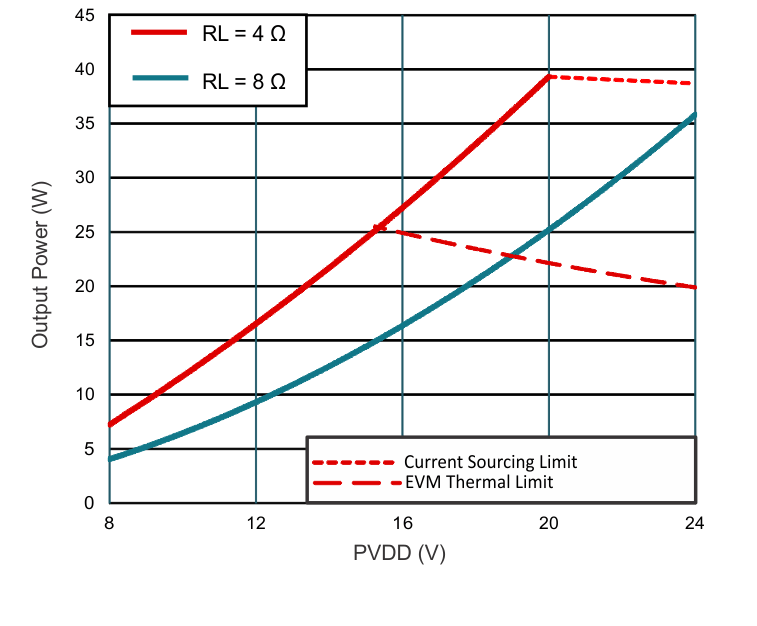 Figure 5. Output Power vs Supply Voltage
Figure 5. Output Power vs Supply Voltage 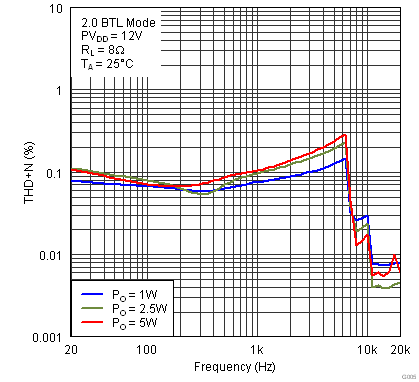 Figure 7. THD+N vs Frequency
Figure 7. THD+N vs Frequency 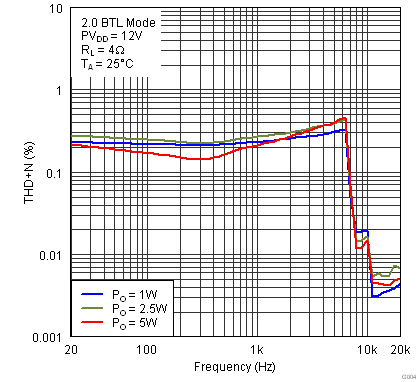 Figure 9. THD+N vs Frequency
Figure 9. THD+N vs Frequency 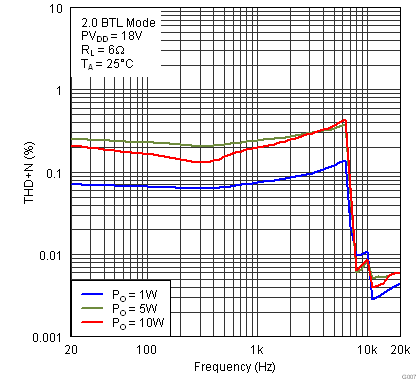 Figure 11. THD+N vs Frequency
Figure 11. THD+N vs Frequency 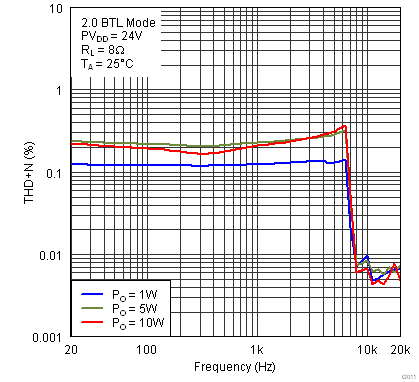 Figure 13. THD+N vs Frequency
Figure 13. THD+N vs Frequency 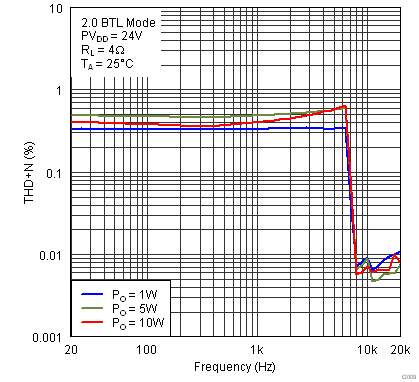 Figure 15. THD+N vs Frequency
Figure 15. THD+N vs Frequency 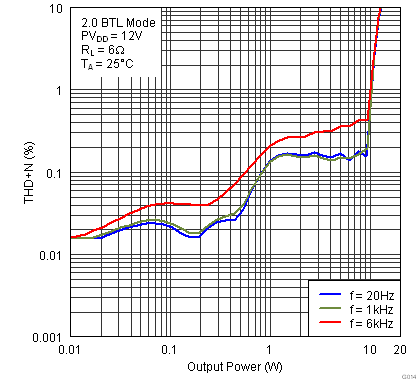 Figure 17. THD+N vs Output Power
Figure 17. THD+N vs Output Power 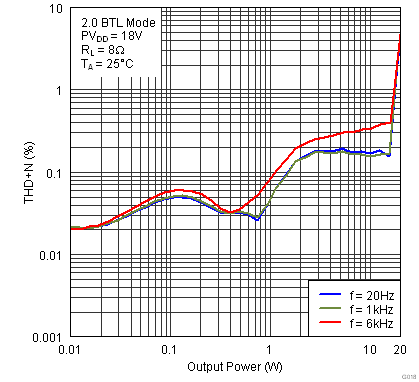 Figure 19. THD+N vs Output Power
Figure 19. THD+N vs Output Power 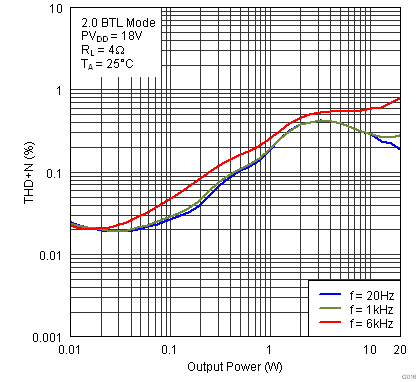 Figure 21. THD+N vs Output Power
Figure 21. THD+N vs Output Power 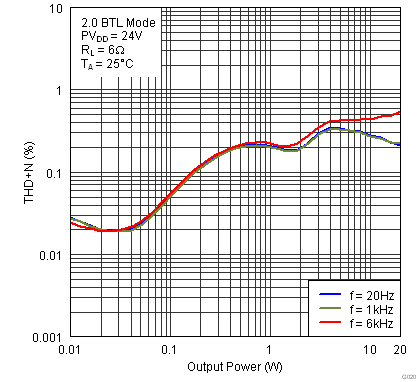 Figure 23. THD+N vs Output Power
Figure 23. THD+N vs Output Power 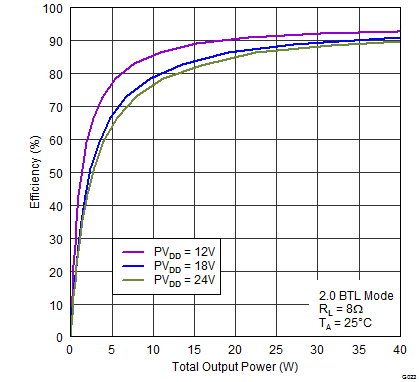
| Total Output Power includes power delivered from both amplifier outputs. For instance, 40 W of total output power means 2 × 20 W, with 20 W delivered by one channel and 20 W delivered by the other channel. |
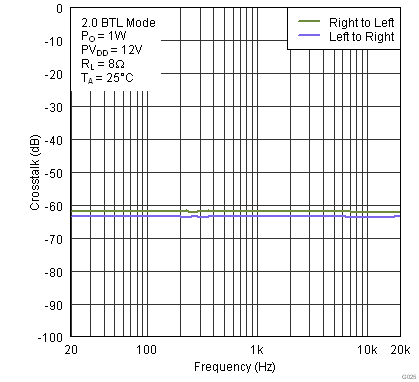 Figure 27. Crosstalk vs Frequency
Figure 27. Crosstalk vs Frequency 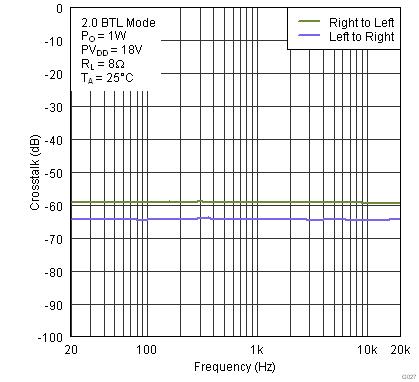 Figure 29. Crosstalk vs Frequency
Figure 29. Crosstalk vs Frequency 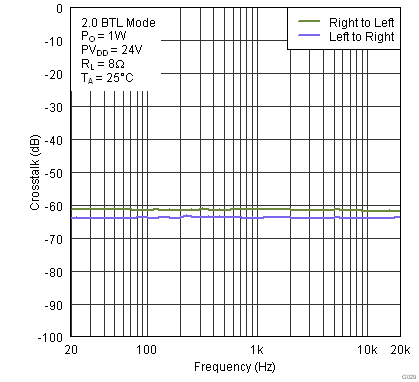 Figure 31. Crosstalk vs Frequency
Figure 31. Crosstalk vs Frequency 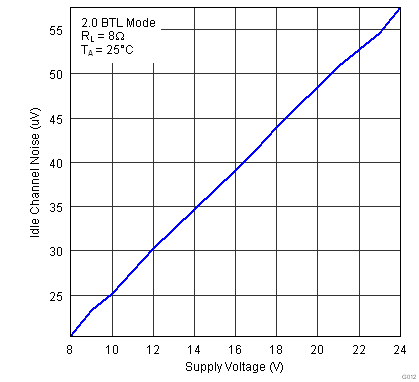 Figure 6. Idle Channel Noise vs Supply Voltage
Figure 6. Idle Channel Noise vs Supply Voltage 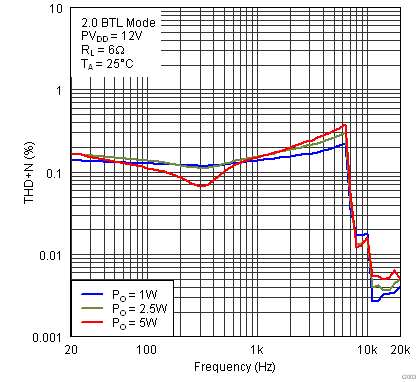 Figure 8. THD+N vs Frequency
Figure 8. THD+N vs Frequency 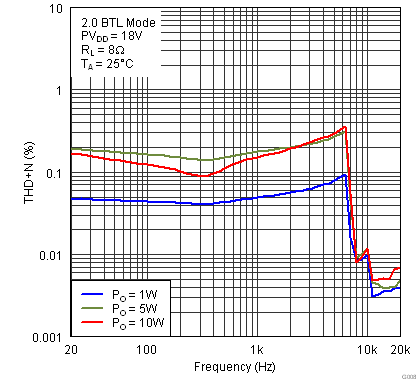 Figure 10. THD+N vs Frequency
Figure 10. THD+N vs Frequency 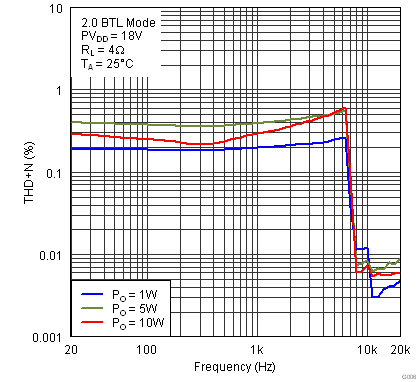 Figure 12. THD+N vs Frequency
Figure 12. THD+N vs Frequency 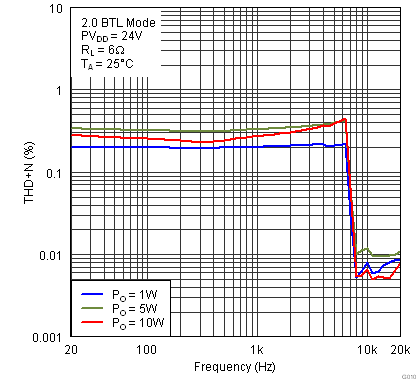 Figure 14. THD+N vs Frequency
Figure 14. THD+N vs Frequency 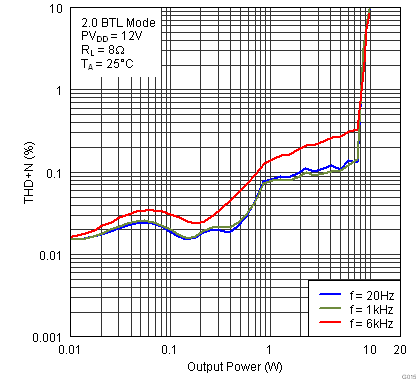 Figure 16. THD+N vs Output Power
Figure 16. THD+N vs Output Power 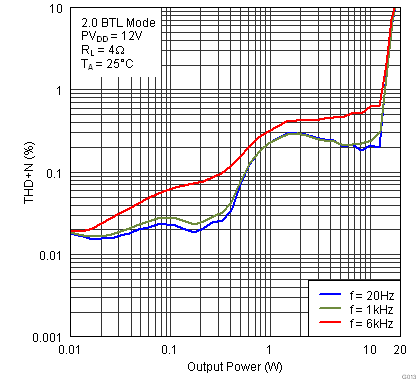 Figure 18. THD+N vs Output Power
Figure 18. THD+N vs Output Power 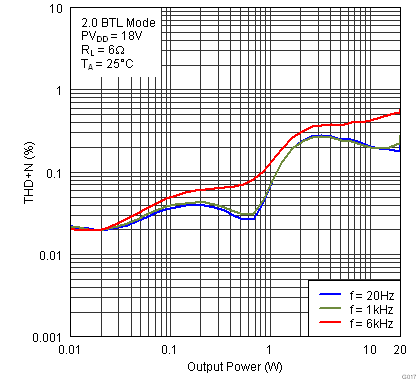 Figure 20. THD+N vs Output Power
Figure 20. THD+N vs Output Power 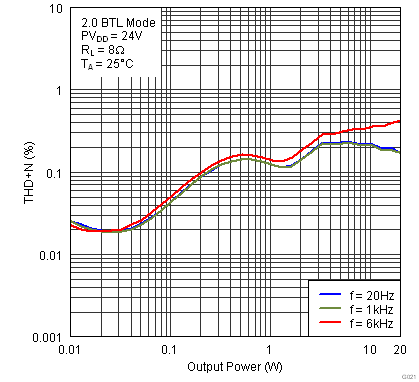 Figure 22. THD+N vs Output Power
Figure 22. THD+N vs Output Power 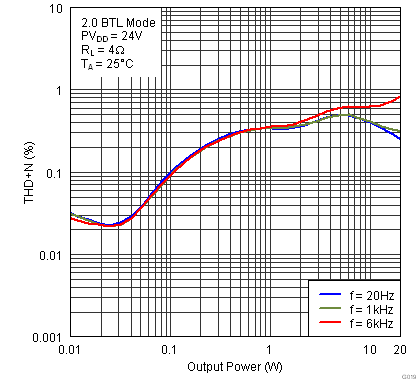 Figure 24. THD+N vs Output Power
Figure 24. THD+N vs Output Power 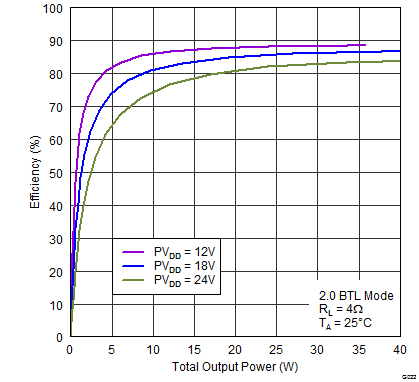
| Total Output Power includes power delivered from both amplifier outputs. For instance, 40 W of total output power means 2 × 20 W, with 20 W delivered by one channel and 20 W delivered by the other channel. |
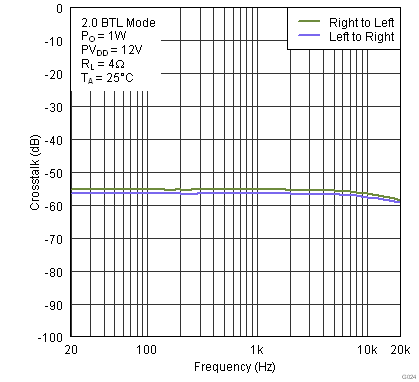 Figure 28. Crosstalk vs Frequency
Figure 28. Crosstalk vs Frequency 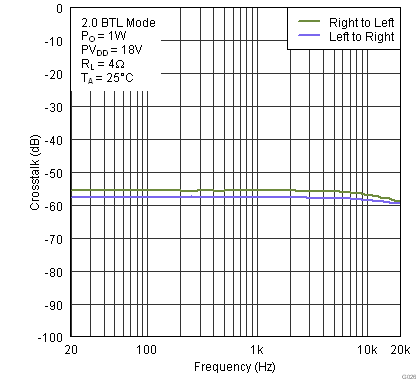 Figure 30. Crosstalk vs Frequency
Figure 30. Crosstalk vs Frequency 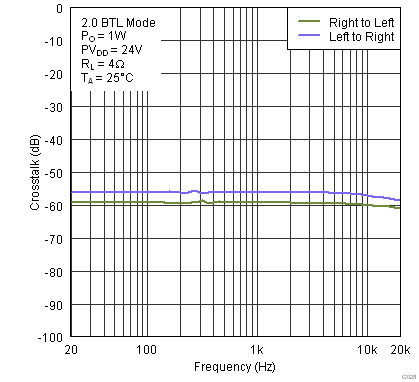 Figure 32. Crosstalk vs Frequency
Figure 32. Crosstalk vs Frequency